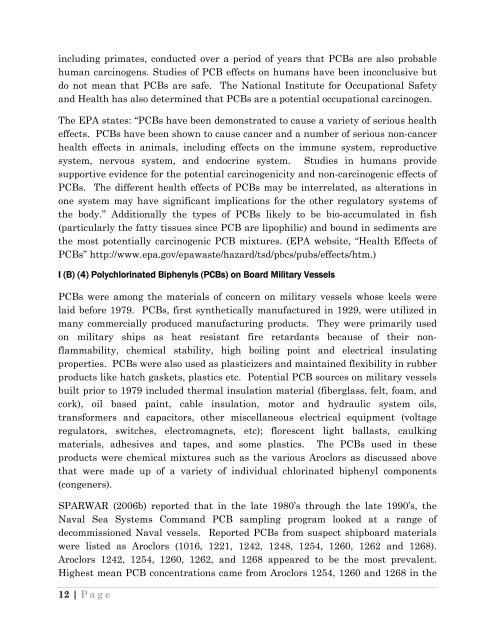Progress report summarizing the reef fish sampling, PCB - Earthjustice
Progress report summarizing the reef fish sampling, PCB - Earthjustice
Progress report summarizing the reef fish sampling, PCB - Earthjustice
You also want an ePaper? Increase the reach of your titles
YUMPU automatically turns print PDFs into web optimized ePapers that Google loves.
including primates, conducted over a period of years that <strong>PCB</strong>s are also probable<br />
human carcinogens. Studies of <strong>PCB</strong> effects on humans have been inconclusive but<br />
do not mean that <strong>PCB</strong>s are safe. The National Institute for Occupational Safety<br />
and Health has also determined that <strong>PCB</strong>s are a potential occupational carcinogen.<br />
The EPA states: “<strong>PCB</strong>s have been demonstrated to cause a variety of serious health<br />
effects. <strong>PCB</strong>s have been shown to cause cancer and a number of serious non-cancer<br />
health effects in animals, including effects on <strong>the</strong> immune system, reproductive<br />
system, nervous system, and endocrine system. Studies in humans provide<br />
supportive evidence for <strong>the</strong> potential carcinogenicity and non-carcinogenic effects of<br />
<strong>PCB</strong>s. The different health effects of <strong>PCB</strong>s may be interrelated, as alterations in<br />
one system may have significant implications for <strong>the</strong> o<strong>the</strong>r regulatory systems of<br />
<strong>the</strong> body.” Additionally <strong>the</strong> types of <strong>PCB</strong>s likely to be bio-accumulated in <strong>fish</strong><br />
(particularly <strong>the</strong> fatty tissues since <strong>PCB</strong> are lipophilic) and bound in sediments are<br />
<strong>the</strong> most potentially carcinogenic <strong>PCB</strong> mixtures. (EPA website, “Health Effects of<br />
<strong>PCB</strong>s” http://www.epa.gov/epawaste/hazard/tsd/pbcs/pubs/effects/htm.)<br />
I (B) (4) Polychlorinated Biphenyls (<strong>PCB</strong>s) on Board Military Vessels<br />
<strong>PCB</strong>s were among <strong>the</strong> materials of concern on military vessels whose keels were<br />
laid before 1979. <strong>PCB</strong>s, first syn<strong>the</strong>tically manufactured in 1929, were utilized in<br />
many commercially produced manufacturing products. They were primarily used<br />
on military ships as heat resistant fire retardants because of <strong>the</strong>ir nonflammability,<br />
chemical stability, high boiling point and electrical insulating<br />
properties. <strong>PCB</strong>s were also used as plasticizers and maintained flexibility in rubber<br />
products like hatch gaskets, plastics etc. Potential <strong>PCB</strong> sources on military vessels<br />
built prior to 1979 included <strong>the</strong>rmal insulation material (fiberglass, felt, foam, and<br />
cork), oil based paint, cable insulation, motor and hydraulic system oils,<br />
transformers and capacitors, o<strong>the</strong>r miscellaneous electrical equipment (voltage<br />
regulators, switches, electromagnets, etc); florescent light ballasts, caulking<br />
materials, adhesives and tapes, and some plastics. The <strong>PCB</strong>s used in <strong>the</strong>se<br />
products were chemical mixtures such as <strong>the</strong> various Aroclors as discussed above<br />
that were made up of a variety of individual chlorinated biphenyl components<br />
(congeners).<br />
SPARWAR (2006b) <strong>report</strong>ed that in <strong>the</strong> late 1980’s through <strong>the</strong> late 1990’s, <strong>the</strong><br />
Naval Sea Systems Command <strong>PCB</strong> <strong>sampling</strong> program looked at a range of<br />
decommissioned Naval vessels. Reported <strong>PCB</strong>s from suspect shipboard materials<br />
were listed as Aroclors (1016, 1221, 1242, 1248, 1254, 1260, 1262 and 1268).<br />
Aroclors 1242, 1254, 1260, 1262, and 1268 appeared to be <strong>the</strong> most prevalent.<br />
Highest mean <strong>PCB</strong> concentrations came from Aroclors 1254, 1260 and 1268 in <strong>the</strong><br />
12 | P age


